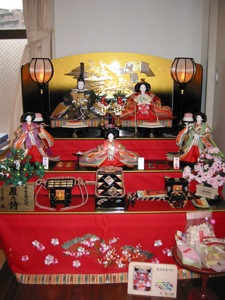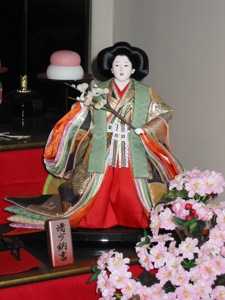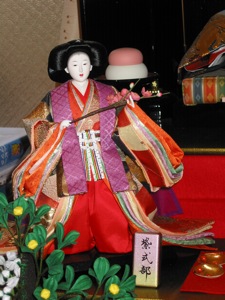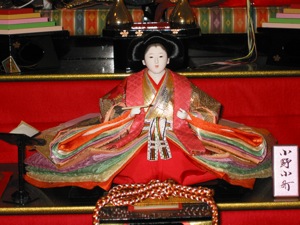
March 3rd 2008
 Mayuki's Hina Ningyou. Click here for a larger photograph.
Mayuki's Hina Ningyou. Click here for a larger photograph.
Today is the Doll Festival, or
The whole set represents a wedding ceremony at the Imperial Court in Heian period Japan, around 1000AD. However, it is not highly historically accurate; it's more a matter of the general image. The lowest shelf has a tachibana tree at the left, and a sakura (cherry) tree at the right; these were the two trees that grew outside the entrance to the Imperial Palace. In the centre, there is a stack of boxes, containing the bride's trousseau, while her palanquin is to the left (as you look), and her ox-drawn carriage to the right.
 The Prince.
The Prince.
The main characters sit on the top level: the prince and princess. These two are the essential element of a Hina display, and the most basic versions only include them. The prince is an imperial prince, in full regalia. His hat is a traditional Japanese crown; these days they are only generally worn by Shinto priests at very formal festivals. The wooden slat in his hand is a shaku, which was a symbol of rank in the Heian period court. Again, these days they are only generally carried by Shinto priests. He also has a sword pushed through his belt.
 The Princess
The Princess
The princess sits beside the prince. She is carrying a fan, which was the woman's equivalent of a shaku. She has a golden crown on her head, and is wearing a twelve-layer kimono. This was the most formal kind of kimono, and was only really worn for weddings. Some people still do; unsurprisingly, it is said to be very heavy, and rather difficult to move in. If you look carefully at the picture, you can just see that she has two spots painted high on her forehead. This is because, in the Heian period, married women used to shave their eyebrows and paint new, false ones on much higher on the forehead. They also blackened their teeth. The famous beauties of the Heian period would most likely not get very far today.
In a completely traditional display, the next level down carries three female servants. However, ours is a bit different, and instead has dolls representing three of the great female poets and authors of the Heian period.
 Sei Shonagon
Sei Shonagon
On the right, the doll represents Sei Shonagon. She is most famous for her Pillow Book. This is not, like later pillow books, about sex. Rather, it is a collection of thoughts and poems that was kept in the author's pillow. (Pillows of the period were hollow boxes of wood. I have a persistent suspicion that they were also padded, but maybe not.) The Pillow Book contains poems, accounts of events, such as the award of court rank to the Emperor's cat or the Empress's treacherous destruction of Sei Shonagon's precious snow mountain, and lists of things in various categories. It opens with such a list: "In spring, the dawn". Sei Shonagon, incidentally, is not her own name. Sei was her family name, and Shonagon is the name of the court office held by her father (if I'm remembering this correctly). Her personal name has not come down to us, as is very common with women of the period; personal names were not used much for women.
 Murasaki Shikibu
Murasaki Shikibu
On the left, the doll represents Murasaki Shikibu. She is the author of the Tale of Genji, the great classic of Japanese literature. She's roughly the Japanese equivalent of Shakespeare. The Tale of Genji tells the story of an imperial prince who is made a commoner because his mother was of low rank, although he remains a high noble. It covers his romantic adventures, but most of all his attachment to a woman known as "Murasaki". Again, "Murasaki Shikibu" was not her given name; she was named "Murasaki" after the character (we know this because part of her diary has also survived, and she recounts the occasion on which it happened), and "Shikibu" is the part of the government in which her family worked. She was a contemporary of Sei Shonagon, around 1000AD; thanks, again, to her diary, we know that she did not think very highly of her rival's literary merits.
 Ono no Komachi
Ono no Komachi
Seated in the centre is Ono no Komachi, a poetess who about 150 years earlier than the other two. You know I mentioned that the display wasn't strictly historically accurate? As well as being famous for her poems, Ono no Komachi was a famous beauty, and was said to have had numerous lovers. Certainly, she seems to have exchanged romantic poems with a number of men. She was recognised as one of the six poetic geniuses of the past in the first Imperial anthology of Japanese verse, a position she still holds today.
This display is thus anchored by three great female poets, who represent gentleness (Sei Shonagon), wisdom (Murasaki Shikibu), and beauty (Ono no Komachi). Since the purpose of the Doll Festival is to celebrate daughters and wish for their successful and happy growth and development, this seemed highly appropriate. Associating my daughter with great authors also seemed appropriate; maybe it will counterbalance her association with a mediocre one.
Our set is actually fairly simple, although it is relatively large. The full set has seven levels of display. Below the three serving women there are five boys with musical instruments, then two guards with bows and arrows, then three male servants. The other two levels have the bride's goods on.
Traditionally, a girl's maternal grandparents give her these dolls. I believe that the most traditional version is to give your first granddaughter in the female line your own dolls, but I'm not sure about that. At any rate, Mayuki's dolls were a cooperative venture between my parents and Yuriko's, and we plan to take good care of them, so that Mayuki will at least have the option of passing them on to her granddaughter.
There is an interesting superstition about the dolls. If you do not put them away quickly after the Doll Festival, your daughter will take a long time to get married. Because we are doing the celebration meal this evening (Yuriko is getting it ready while I write this), we plan to put them all away tomorrow. But in our case it's largely because, beautiful as they are, they have taken over quite a large section of our living room; it will be nice to have the space back, at least until next year.